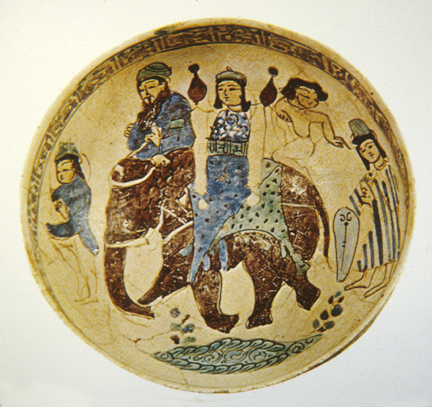
Mina'i Bowl from Kashan, Fritware with Underglaze Cobalt and Overglaze Enamel, 1218 CE
ART 198 - HISTORY OF WORLD CERAMICS
| Another overglaze technique developed by the potters of Kashan was the use of overglaze enamels, and this technique was called mina'i, which literally means enamel. Enamel is a low fire glaze, usually fluxed with lead, and the main reason enamel was used was to widen the available color palette. At low temperatures, more colors are possible. The ware was first bisque fired, then painted in underglaze cobalt, covered with a transparent glaze and fired again to melt the glaze. Next the oil based enamels were painted onto this surface and the piece fired a third, or even successive times, to melt the colored enamels onto the ware. Many variations on this technique were utilized. On this bowl from Kashan, we see a very rare depiction of an elephant on mina'i ware. Typical scenes include tales from Persian legends, scenes from the hunt with falcons and horses, caravans, or court scenes. These paintings are often compared to those found in the miniatures of manuscript illumination from books of the period. Sometimes, the overglaze enamels were fired atop a turquoise colored glaze as well. | Mina'i Bowl from Kashan, Fritware with Underglaze Cobalt and Overglaze Enamel, 1218 CE |
|
|